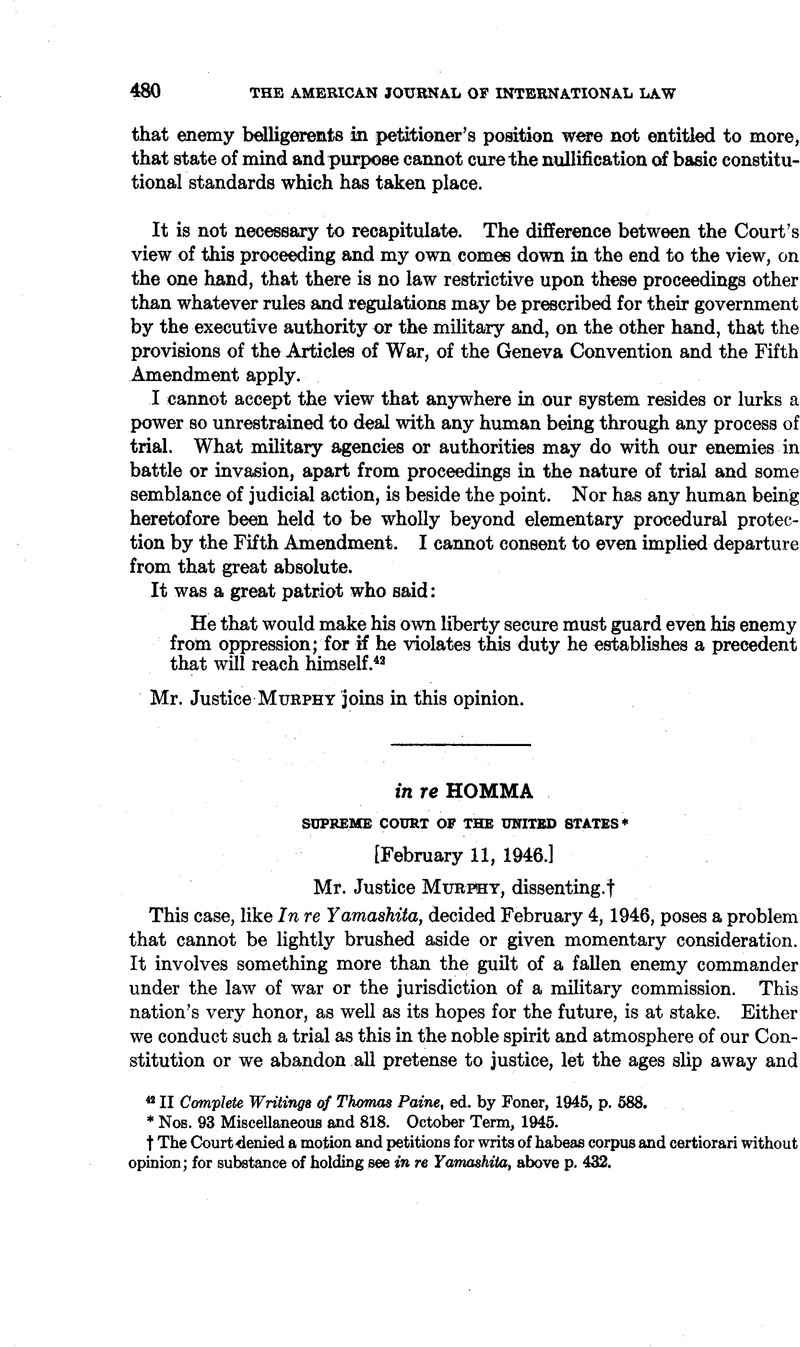No CrossRef data available.
Article contents
In re Homma
Published online by Cambridge University Press: 20 April 2017
Abstract

- Type
- Judicial Decisions
- Information
- Copyright
- Copyright © American Society of International Law 1946
References
* Nos. 93 Miscellaneous and 818. October Term, 1945.
1 The directive or order prescribing the regulations governing the trial was issued December 5,1945, and provided in Paragraph 5d Evidence (7):” All purported confessions or statements of the accused shall be admissible without prior proof that they were voluntarily given, it being for the Commission to determine only the truth or falsity of such confessions or statements.” (Emphasis added.) In addition to the further provisons set forth in notes 2 and 3, the order provided for the reception of evidence in even broader terms if possible than the directive relating to similar matters which covered General Yamashita’s trial.
2 Paragraph 5d Evidence also contained the following subdivision (4): “If the accused is charged with an offense involving concerted criminal action upon the part of a military or naval unit, or any group or organization, evidence which has been given previously at a trial resulting in the conviction of any other member of that unit, group or organization, relative to that concerted offense, may be received as prima facie evidence that the accused likewise guilty of that offense.”
3 Paragraph 5d Evidence (5) is as follows: “The findings and judgment of a commission in any trial of a unit, group, or organization with respect to the criminal character, purpose or activities thereof shall be given full faith and credit in any subsequent trial, by that or any other commission, of an individual person charged with criminal responsibility through membership in that unit, group or organization. Upon proof of membership in that unit, group or organization convicted by a commission, the burden shall be on the accused to establish by proof any mitigating circumstances relating to his membership or participation therein.”
4 The following is a bare chronological statement concerning the constitution of the commission and subsequent events: On December 5, 1945, the regulations governing the trial were issued; December 6, the order to General Styer to appoint the commission followed; on December 12, petitioner was transferred-from Japan to Manila; December 15, counsel for the defense was appointed; December 17, the charge was served on petitioner, substantially identical with that in the Yamashita case, containing 47 specifications of the same general type there involved, together with a supplemental charge that on May 6, 1942, petitioner refused to grant quarter to the armed forces of the United States and its allies in Manila Bay, Philippines; December 19, the commission convened, counsel were sworn, petitioner was arraigned, pleaded not guilty and entered a motion for thirty days time to prepare defense before trial. The motion was denied. On January 3, 1946, the commission reconvened. The prosecution then filed a bill of particulars to two of the specifications. Petitioner’s plea to the jurisdiction, motion to dismiss, motions for bills of particulars relating to certain items in the specifications, and for further particulars concerning other items were denied. The commission also then denied the motion of counsel for the defense to postpone the trial for ten days. This motion was supported by affidavit of chief counsel, dated January 2,1945, which set forth that he and his associates began work on preparing the defense on December 16; that “each of the 48 specifications requires a detailed investigation and that eighteen days have proved insufficient time to accomplish even a small portion of this investigation “; that two members of the defense staff who had left for Tokyo on December 25 to interview witnesses and secure other evidence had not returned; that two of three investigators originally assigned to the defense were ill and in the hospital, one from December 21, the other from December 24, and that only one additional investigator had been assigned to the defense, though others had been promised; that on January 2 the defense had received from the prosecution eleven “typical cases” on which proof was to be offered under specification 4 and nine “representative instances” under specification 47, which the defense had no opportunity to investigate. The affidavit concluded with the statement that a minimum period of ten days was required before counsel could be prepared to proceed with the trial.
The trial began in the afternoon of January 3. On January 16 petitions for writs of habeas corpus and prohibition were filed in the Supreme Court of the Philippines. They were denied January 23 without argument. The petitions and motions constituting this application were filed in this Court February 7, 1946.


